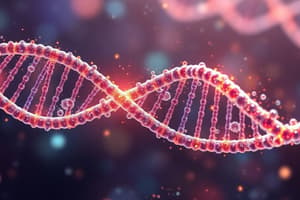Podcast
Questions and Answers
What is the primary function of a restriction enzyme?
What is the primary function of a restriction enzyme?
- To replicate DNA in a host cell
- To cut DNA at specific sequences (correct)
- To visualize DNA fragments
- To synthesize DNA from RNA
What type of ends does a restriction enzyme generate when it cuts DNA?
What type of ends does a restriction enzyme generate when it cuts DNA?
- Non-specific ends
- Blunt ends or sticky ends (correct)
- Double-stranded ends
- Circular ends
What is the primary function of ethidium bromide (EtBr) in electrophoresis?
What is the primary function of ethidium bromide (EtBr) in electrophoresis?
- To create DNA fragments
- To intercalate between DNA bases (correct)
- To degrade DNA fragments
- To enhance DNA replication
Which component of a cloning vector ensures that the vector can replicate independently within a host cell?
Which component of a cloning vector ensures that the vector can replicate independently within a host cell?
Which method is used to visualize DNA fragments after gel electrophoresis?
Which method is used to visualize DNA fragments after gel electrophoresis?
What role does the antibiotic resistance gene (e.g., AmpR) play in plasmid selection?
What role does the antibiotic resistance gene (e.g., AmpR) play in plasmid selection?
During DNA gel electrophoresis, what determines the speed at which DNA fragments migrate?
During DNA gel electrophoresis, what determines the speed at which DNA fragments migrate?
What is a major difference between bacterial artificial chromosomes (BACs) and yeast artificial chromosomes (YACs)?
What is a major difference between bacterial artificial chromosomes (BACs) and yeast artificial chromosomes (YACs)?
Which of the following describes a key regulatory element difference between expression vectors and cloning vectors?
Which of the following describes a key regulatory element difference between expression vectors and cloning vectors?
What is the purpose of the selectable marker in a cloning vector?
What is the purpose of the selectable marker in a cloning vector?
What two characteristics of DNA fragments does gel electrophoresis utilize for separation?
What two characteristics of DNA fragments does gel electrophoresis utilize for separation?
Which of the following is a consequence of using bacterial expression vectors for human gene proteins?
Which of the following is a consequence of using bacterial expression vectors for human gene proteins?
What process is used to introduce a recombinant plasmid into bacterial cells?
What process is used to introduce a recombinant plasmid into bacterial cells?
What is the main purpose of using expression vectors in genetic engineering?
What is the main purpose of using expression vectors in genetic engineering?
Which characteristic differentiates a cloning vector from an expression vector?
Which characteristic differentiates a cloning vector from an expression vector?
How do the uses of YACs and BACs typically differ?
How do the uses of YACs and BACs typically differ?
Flashcards are hidden until you start studying
Study Notes
Restriction Enzymes
- Proteins that cut DNA at specific sequences.
- Make two cuts in double-stranded DNA (dsDNA) creating blunt ends (straight cuts) or sticky ends (staggered cuts with overhangs).
- Useful in genetic engineering and molecular biology for fragment generation.
Cloning the Human Insulin Gene
- Isolate the insulin gene by extracting mRNA from human pancreatic cells and converting it to complementary DNA (cDNA).
- Prepare a vector by cutting a bacterial plasmid with a restriction enzyme to create sticky ends.
- Ligate the insulin cDNA into the plasmid, creating a recombinant plasmid.
- Transform bacterial cells with the recombinant plasmid and select for successful transformants.
- Screen bacterial clones to confirm the presence of the insulin gene.
- Induce growth and purify the produced insulin protein.
Characteristics of a Cloning Vector
- Origin of Replication (ori): Enables independent replication within the host cell.
- Selectable Marker: Typically an antibiotic resistance gene, allowing identification of cells that have taken up the vector.
- Multiple Cloning Site (MCS): Contains unique restriction enzyme sites for easy insertion of foreign DNA.
DNA Gel Electrophoresis
- Separation Characteristics: DNA fragments are separated based on size and charge.
- Migration Process: DNA samples loaded in a gel move towards the positive electrode; smaller fragments migrate faster and further, forming distinct bands.
- Visualization: Ethidium bromide (EtBr) is commonly used, intercalating with DNA and fluorescing under UV light for band visibility.
Selectable Markers in Plasmids
- Antibiotic Resistance Gene: Provides survival advantage on antibiotic media, enabling selection of transformed bacteria.
- LacZ Gene: Codes for β-galactosidase, turning blue in the presence of X-gal; white colonies indicate successful gene insertion.
Types of Vectors
- Bacterial Artificial Chromosomes (BACs): Can carry large fragments (up to 300,000 base pairs); ideal for cloning extensive DNA segments in bacterial cells.
- Yeast Artificial Chromosomes (YACs): Larger capacity (up to 1 million base pairs); useful for cloning very large DNA sequences in yeast cells.
Differences Between Expression and Cloning Vectors
- Purpose: Cloning vectors amplify DNA; expression vectors produce proteins encoded by genes.
- Regulatory Elements: Cloning vectors have basic elements; expression vectors include promoters and binding sites for protein synthesis.
- End Product: Cloning vectors yield multiple DNA copies; expression vectors yield the protein product.
Drawbacks of Bacterial Expression Vectors for Human Genes
- Lack of Post-Translational Modifications: Bacteria cannot perform complex modifications (e.g., glycosylation), essential for human protein function.
- Protein Misfolding and Aggregation: Human proteins may misfold or aggregate in bacteria, resulting in non-functional proteins.
Studying That Suits You
Use AI to generate personalized quizzes and flashcards to suit your learning preferences.




